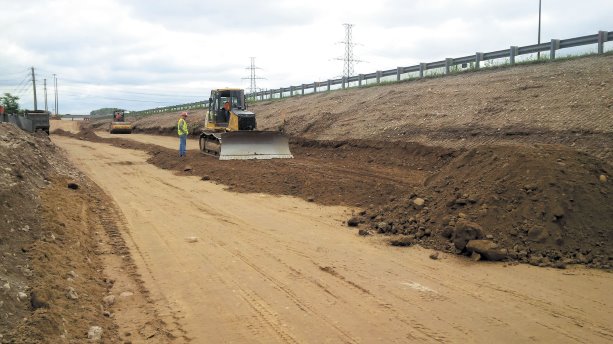A massive road project in Southwestern Ontario got underway in June and will continue into 2019.
Stretching from the Highway 8 to the Hespeler Road interchanges in the Cambridge area, the $112-million widening and reconstruction of a 4.2-kilometre-long (2.6-mile) section of Highway 401 is intended to improve traffic movement.
The project includes widening the highway from six to 10 lanes and a complete reconstruction of the six existing lanes — two of which will be transformed in HOV lanes—plus the staged erection of four new four-span steel girder bridges (with concrete decks) over the Speed River and several major improvements.
Dufferin Construction is the general contractor. The design consultant is Parsons Inc. and the contract administration consultant is Morrison Hershfield.
"Traffic has increased drastically in the area in the past 15 to 20 years. Approximately 400,000 vehicles a day use that stretch," says Ontario Ministry of Transportation project manager Scott Howard.
Contributing to that traffic volume is new growth in the area, commuters travelling west to Toronto for work and long-haul traffic along the Highway 401 corridor, he says.
"Widening Highway 401 in the Cambridge area will help improve traffic flow for residents and businesses."
Drivers, though, shouldn’t expect to see relief overnight and can expect delays over the duration of the project, he says.
"This is a highly-complex construction project. One major challenge is planning traffic staging to accommodate current traffic levels."
This year Dufferin will be constructing the new eastbound and westbound outer lanes, so drivers will continue to use the existing lanes, says Howard, who expects the new lanes to be opened in the fall of 2018.
"Once the outer lanes are complete and traffic is moved to the new lanes, the contractor will undertake the demolition and construction of the new bridges from the existing lanes, staging accordingly to facilitate the work."
The project also encompasses the compete reconstruction of the existing lanes using a combination of both Superpave and Stone Mastic Asphalt layers. Included in that reconstruction will be the changeover of the centre lanes into HOV lanes (one east, one west) adjacent the central median.
However, that conversion may not occur until the final year of the project since those lanes will probably be used for staging purposes, says Howard.
The HOV lanes will be the first of their kind in the Ministry’s southwest region, an area which stretches from Windsor to Milton and north to Tobermory. As other Highway 401 projects roll out, they will eventually be extended all the way east into the Greater Toronto Area, he says.
Another significant enhancement will be the building of 4.25-metre-wide (14-foot) bus-only shoulders at the urging of the Region of Waterloo which is funding the cost of that phase of the project.
"Buses will only be able to use the shoulders when congestion reduces the travelling speeds in the general purpose lanes to 50 kilometres or less."
Other work to be carried out by Dufferin includes widening and repairing two railway overpasses (owned respectively by CN and Grand River Electric Railway) and the rehabilitation of the Hespeler Road southbound bridge to accommodate the Highway 401 traffic.
Despite the heavy schedule of tasks, three lanes of traffic in each direction will be open at all times. The lanes will be shifted within the highway corridor, depending on the location of the construction, and some night time work will require a periodic reduction to two lanes, says Howard.



Recent Comments
comments for this post are closed